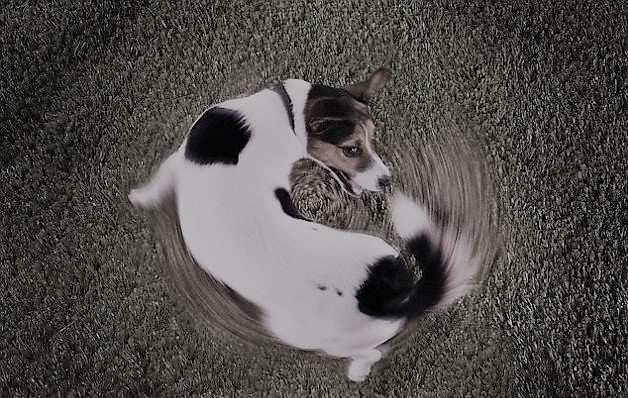Why does my dog chase his tail?
For some people, watching their dog spinning around as he’s trying to catch his tail is an amusing rarity, for others it can be a really worrying habit that happens several if not many times a day. The latter can be a very stressful situation for the owner, as well as the dog, who seems unable to help himself.
So why does a dog chase his tail?
It’s ok to ignore the occasional chase of the tail if it happens very rarely, as it is probably just a momentary amusement for your dog. It’s important not to make a big fuss about it or give him food or affection immediately after as this could be seen by your dog as encouragement of the behaviour.
If your dog is chasing his tail on a regular basis – enough for you to know that there is some kind of abnormality in the behaviour (for example, mine may chase her tail once or twice a year), it’s important to get to the bottom of it.
There are a number of reasons he could be displaying this behaviour and it ranges from medical to psychological:
- A medical condition
- Fleas/worms
- Impacted/itchy anal glands
- Boredom/Attention
- Genetics
- Compulsion
The first thing to do when you notice the behaviour is to take your dog to the vet to make sure there are no underlying medical causes for the behaviour. While you are there you can ask the vet to check your dog’s anal glands and empty them if they are full. You can also check that his flea and worming prevention is up to date. That takes care of causes one to three.
If all of that is ok and your dog is still obsessively chasing his tail it could be down to one of the more complicated psychological reasons mentioned in points four to six.
Boredom is a factor that can cause a large number of behavioural issues, tail chasing being one of them. It can be grouped with ‘lack of exercise’ as the two usually go hand in hand. Ensuring that your dog is getting the right amount of exercise for his energy level and needs, is a great way to help combat boredom and help maintain your dog’s physical and mental wellbeing. A tired dog is a good dog – if yours is getting the right amount of exercise and mental stimulation he shouldn’t have the inclination or energy to chase his tail obsessively. You should find ways to stimulate your dog mentally with games, puzzles, training and activities to help combat boredom.
If your dog gets lots of positive attention when chasing his tail such as everyone in the room looking at him, laughing, smiling, calling his name, he may decide that this is a great way to get some extra fuss. If this is the case he will usually only chase his tail when he is in the company of people. The best thing to do in this case is to just ignore him. You can get up and walk out the room even. If he still continues you can do something that you know will get his attention without you having to call his name or look at him (such as opening the back door or walking towards the front door) Every now and then, reward him with a gentle pat or a soft ‘good boy’ when he is being calm and quiet – reinforcing that behaviour instead.
Genetics is a tricky one to deal with as there is nothing you can do to influence that once you already have your dog. Ensuring you do due diligence when selecting a breeder and spending a decent amount of time in the company of the parent dogs, will go a long way in helping you decide whether the breeder and the puppy will be right for you or not. If you already have the puppy/dog or if it was a rescue, his genetics could be predisposing him to tail chasing. This doesn’t mean all hope is lost, however, as you are still able to influence his behaviour by addressing the other psychological causes.
Just like humans, dogs can also develop compulsive disorders. Tail chasing is a common one, as well as licking. These can be soothing for the dog who finds comfort in the repetitive behaviour. It could be caused by any number of things (anxiety, abuse, confinement, trauma) and needs to be addressed as quickly as possible. The longer the behaviour is allowed to go on, the more embedded it becomes. Dogs can cause serious injury to themselves if they catch and/or chew their tails and can result in bleeding, infection, hair loss and amputation of the damaged tissue.
If you think your dog’s tail chasing is a potential issue then the best bet is to get him checked by your vet. If he gets the all clear from the vet you need to start thinking about getting professional help to resolve the issue – a happy, fulfilled dog will not be indulging in this type of behaviour and you owe it to your furry friend to get him the help he deserves.






